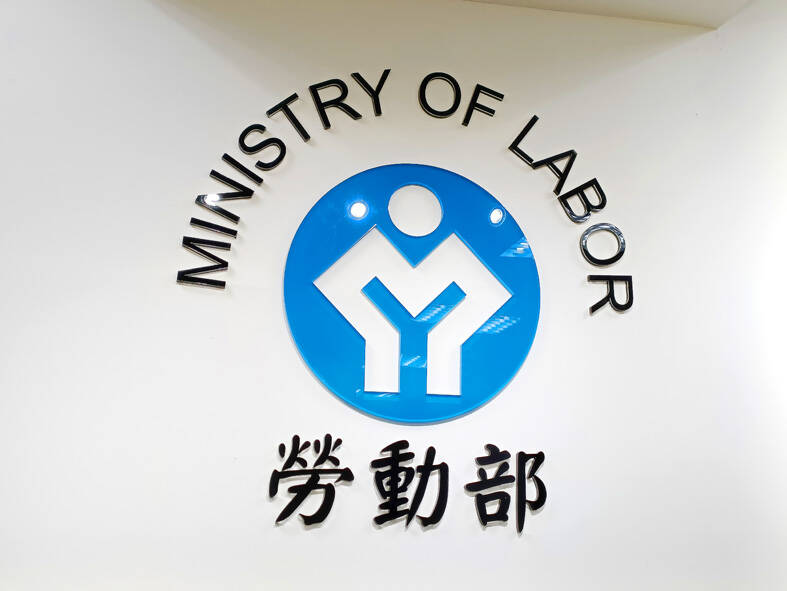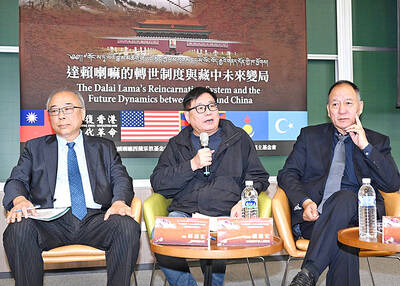Gender and age discrimination were the two most common forms of discrimination in the workplace in the past year, the Ministry of Labor said in a report yesterday.
Discrimination based on physical appearance and rank were the other most commonly cited factors, the report said.
The findings were the result of a survey conducted by the ministry to determine the effectiveness of the Gender Equality in Employment Act (性別平等工作法).

Photo: Lee Ching-hui, Taipei Times
In the 22 years since the act was promulgated, the percentage of businesses with more than 30 employees implementing sexual harassment prevention and reporting protocols has improved by more than 53 percentage points, from 35.5 percent to 88.8 percent, the ministry found.
From August 2023 to July last year, 3.6 percent of women and 0.8 percent of men reported that they had experienced sexual harassment in the workplace.
Women who faced harassment said it mostly came from colleagues or clients, with most reported harassment being “non-physical,” such as verbal abuse, unwanted photography, stalking and unwanted messaging.
Sexist remarks and physical contact were the next two most-reported forms of harassment.
The ministry also investigated gender-based unequal treatment in the workplace, finding that 2.8 percent of women received unequal wages compared with their male colleagues, and 1.9 percent reported receiving less-favorable work assignments.
Apart from gender, age discrimination was the most common form, with 3.6 percent of women and 4.5 percent of men reporting that it had happened to them.
For women, the next most-common forms of discrimination were class or rank within the company, physical appearance, and ideology or thinking, all ranging from 1.6 percent to 1.8 percent.
Men reported physical appearance, rank within the firm, and political affiliation as their next most-common form of harassment, ranging from 1.4 percent to 2.1 percent.
The survey collected 3,114 samples from public institutions and 6,901 from private employers, with 4,801 respondents identifying as women and 2,100 as men.

ALIGNED THINKING: Taiwan and Japan have a mutual interest in trade, culture and engineering, and can work together for stability, Cho Jung-tai said Taiwan and Japan are two like-minded countries willing to work together to form a “safety barrier” in the Indo-Pacific region, Premier Cho Jung-tai (卓榮泰) yesterday said at the opening ceremony of the 35th Taiwan-Japan Modern Engineering and Technology Symposium in Taipei. Taiwan and Japan are close geographically and closer emotionally, he added. Citing the overflowing of a barrier lake in the Mataian River (馬太鞍溪) in September, Cho said the submersible water level sensors given by Japan during the disaster helped Taiwan monitor the lake’s water levels more accurately. Japan also provided a lot of vaccines early in the outbreak of the COVID-19 pandemic,

Kaohsiung Mayor Chen Chi-mai (陳其邁) on Monday announced light shows and themed traffic lights to welcome fans of South Korean pop group Twice to the port city. The group is to play Kaohsiung on Saturday as part of its “This Is For” world tour. It would be the group’s first performance in Taiwan since its debut 10 years ago. The all-female group consists of five South Koreans, three Japanese and Tainan’s Chou Tzu-yu (周子瑜), the first Taiwan-born and raised member of a South Korean girl group. To promote the group’s arrival, the city has been holding a series of events, including a pop-up

TEMPORAL/SPIRITUAL: Beijing’s claim that the next Buddhist leader must come from China is a heavy-handed political maneuver that will fall flat-faced, experts said China’s requirement that the Dalai Lama’s reincarnation to be born in China and approved by Beijing has drawn criticism, with experts at a forum in Taipei yesterday saying that if Beijing were to put forth its own Dalai Lama, the person would not be recognized by the Tibetan Buddhist community. The experts made a remarks at the two-day forum hosted by the Tibet Religious Foundation of His Holiness the Dalai Lama titled: “The Snow Land Forum: Finding Common Ground on Tibet.” China says it has the right to determine the Dalai Lama’s reincarnation, as it claims sovereignty over Tibet since ancient times,

Temperatures in some parts of Taiwan are expected to fall sharply to lows of 15°C later this week as seasonal northeasterly winds strengthen, the Central Weather Administration (CWA) said today. It is to be the strongest cold wave to affect northern Taiwan this autumn, while Chiayi County in the southwest and some parts of central Taiwan are likely to also see lower temperatures due to radiational cooling, which occurs under conditions of clear skies, light winds and dry weather, the CWA said. Across Taiwan, temperatures are to fall gradually this week, dropping to 15°C to 16°C in the early hours of Wednesday